
The Bottom Line
Introduction
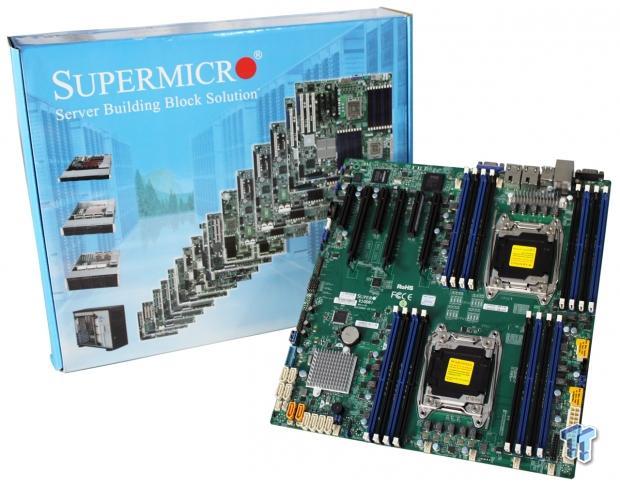
The Supermicro X10DRi-T motherboard comes in as a direct upgrade to the X9DR3/i-F SKU line. The X9DR3/i-F is a high-volume motherboard for Supermicro, so we expect the X10DRi-T will also be high-volume. As a general-purpose server motherboard, this kit fits into a typical Supermicro 4U tower case for workstations, or it can be installed in 2U and 3U server cases for storage and other applications.
The Supermicro X10DRi-T motherboard comes in two different versions, the X10DRi and X10DRi-T. The X10DRi is has network options (Intel i350 Dual port GbE LAN). And the X10DRi-T adds advanced network options (Intel X540 Dual port 10GBase-T).
Both the X10DRi and X10DRi-T support dual Intel E5-2600 v3 processors (Socket R3) based on new Intel Microarchitecture 22nm process technology. These features deliver high system performance, and power efficiency. These motherboards also feature the PCH C612, which supports Hybrid-clock, Intel's Node Manager 3.0, Intel Management Engine, and new DDR4 with speeds up to 2133MHz.
The key features of the X10DRi-T server motherboard are:
- Dual HSW EP E5-2600 v3 (Socket R3 up to 145W), QPI up to 9.6GT/s
- Intel C612 chipset
- 16 DIMM, 1TB Reg. ECC DDR4 up to 2133 MHz
- Three PCIe 3.0 x16, Three PCIe 3.0 x8
- Dual Intel X540 Dual port 10GBase-T network
- Ten SATA3, eleven USB Ports (six USB 3.0)
- 12" x 13" E-ATX Form Factor
This motherboard can handle up to 145W processors, which allows it to run the E5-2699 v3 (18 core) CPUs. Ten SATA ports are very common on the new platforms, so you should have no issues with storage options.
PRICING: You can find the Supermicro X10DRi-T for sale below. The prices listed are valid at the time of writing, but can change at any time. Click the link to see the very latest pricing for the best deal.
United States: The Supermicro X10DRi-T retails for $550.17 at Amazon.
Specifications and Layout
Specifications
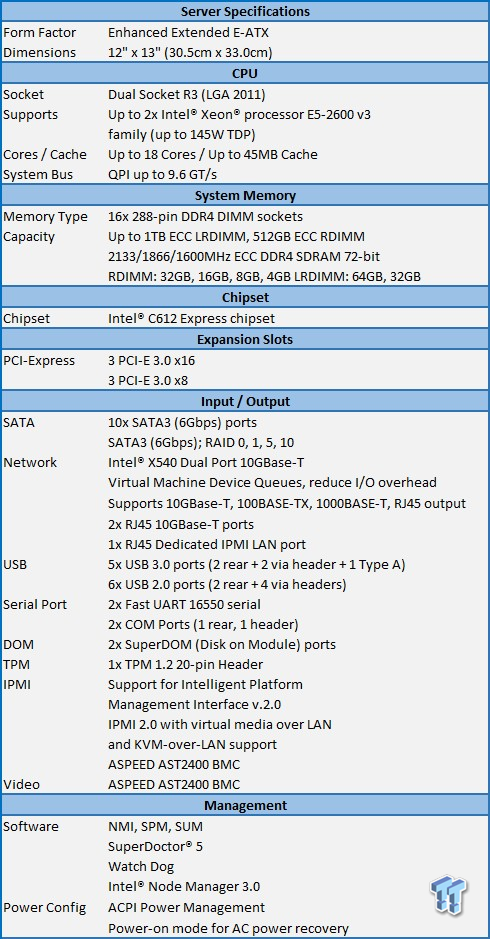
We only received the X10DRi-T motherboard for our tests. The retail package should contain:
- Six (6) SATA Cables - 61cm flat S-S PBF
- One (1) I/O Shield
- One (1) Quick Reference Guide
Optional accessories are:
- Heat Sinks - Socket 2011-3 Narrow
- TPM security module - TPM module with Infineon 9655, RoHS/REACH, PBF; Vertical or Horizontal, depending on the server layout and expansion cards used
- SuperDOM - Supermicro SATA DOM Solutions
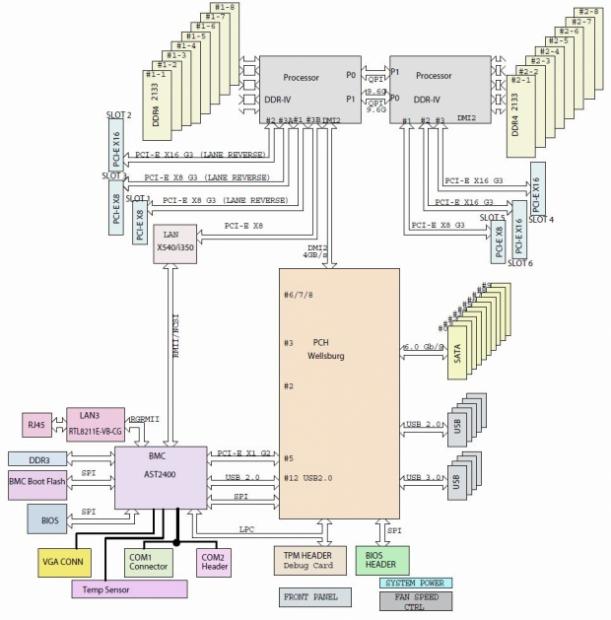
Here we get a look at the block diagram that shows how all the input and output devices connect to the C612 Chipset, which uses new Intel microarchitecture 22nm process technology.
The PCH C612 chip provides Enterprise SMbus support and includes the following features:
- DDR4 288-pin memory support on Socket R3
- Hybrid clock support capable of extending to most 2S platforms
- Support for Management Engine (ME)
- Support of SMBus speeds of up to 400KHz for BMC connectivity
- Improved I/O capabilities to high storage capacity configurations
- SPI Enhancements
- Intel Node Manager 3.0 for advanced power monitoring; capping and management for BMC enhancement (See the note below)
- BMC supports remote management, virtualization, and the security package for enterprise platforms
Layout

Here we get our first look at the X10DRi-T workstation motherboard.
With a size of 12" x 13", E-ATX form factor, the X10DRi-T can fit many different cases that include rack mount types and 4U tower cases. Please note that a Revision M chassis is recommended for this motherboard.
The overall layout of the X10DRi-T is clean, not cluttered, and the CPU Sockets are staggered to offer better airflow to the processor heat sinks.
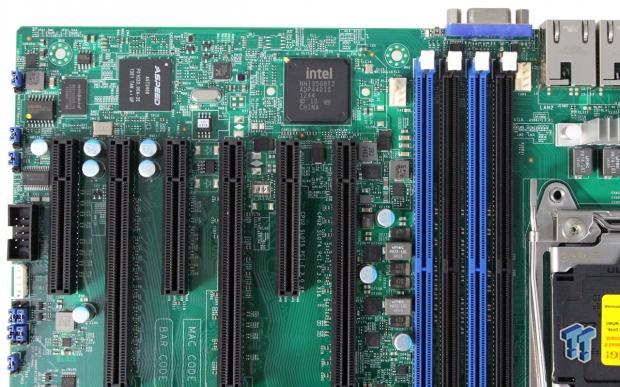
Here we see the PCIe slots, which are:
- Three PCI-E 3.0 x16
- Three PCI-E 3.0 x8
The first PCIe slot is in line with the RAM slots of CPU one, so make sure that your expansion card will fit into this slot.
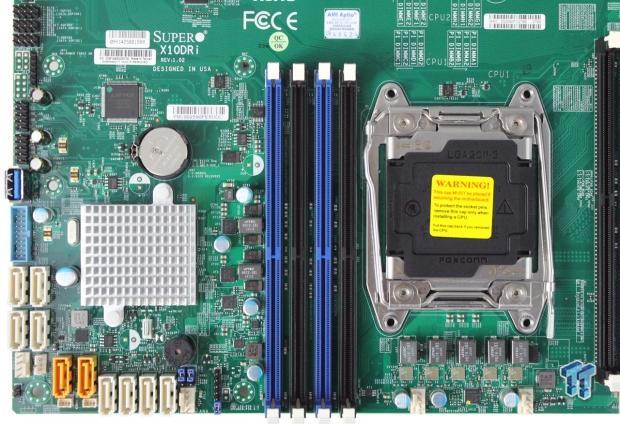
Now we are looking at the lower left side of the motherboard. There are ten SATA ports seen here. The Intel SCU controls the top four S-SATA Ports (0-3). The remaining six I-SATA Ports (0-5) are controlled by the Intel PCH C612 chipset. These SATA ports support RAID 0, 1, 10, and 5.
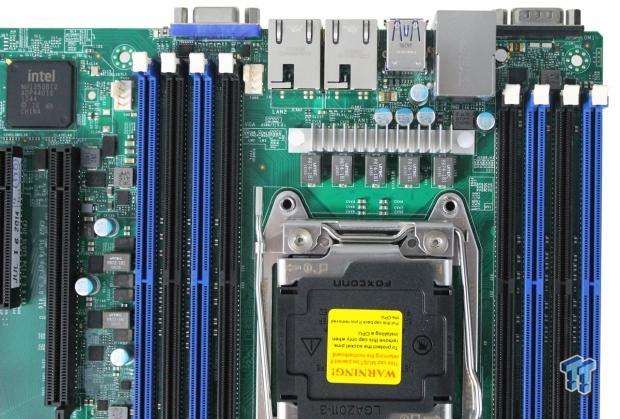
Here we are looking at the upper right section of the motherboard. There are only two fan headers located here.
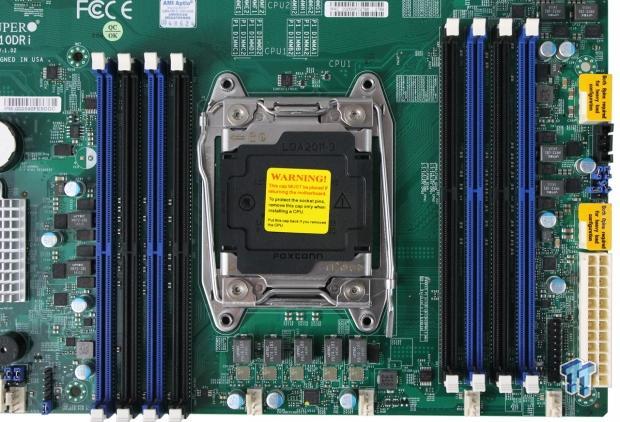
The lower right side of the motherboard has its main power connectors over on the right edge on the motherboard. There are also five fan headers located on the edge of the motherboard.
Here we see a close up of the new Socket 2011 R3. The X10DRi-T uses the narrow version of Socket 2011-3. As you can see, it looks very much like the normal Socket 2011 that we have seen on past boards. However, last gen processors will not fit this new socket because it has a different pin configuration, and notches inside the socket will only work on the new Haswell-EP E5-2600 v3 processors.
The mounting holes for heat sinks are the same as those used on Socket 2011 systems, so you should have no problems using those heat sinks.

Now we are looking at the back I/O Ports. At the left, we see the COM port. Next, we find two USB 2.0 ports, and an IPMI Dedicated LAN port. Next are two USB 3.0 ports. Then we find two 10GBase-T Ethernet ports. And finally, we have the video-out port, supported by ASPEED AST2400 BMC.
BIOS, Remote Management, and Software
BIOS
The BIOS for this motherboard is standard for server motherboards, so we will only show a few BIOS screens and go over new menu options.
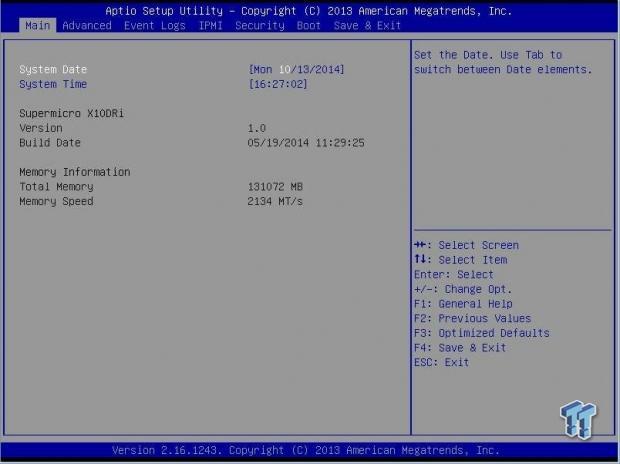
This is the main BIOS screen, which shows basic system information.
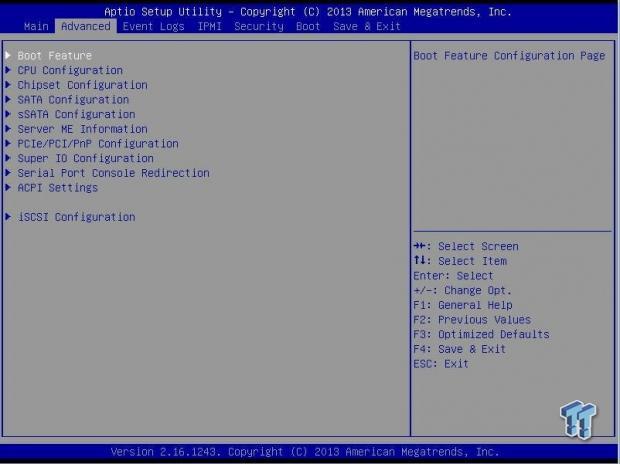
The Advanced tab brings you to the main advanced screen.
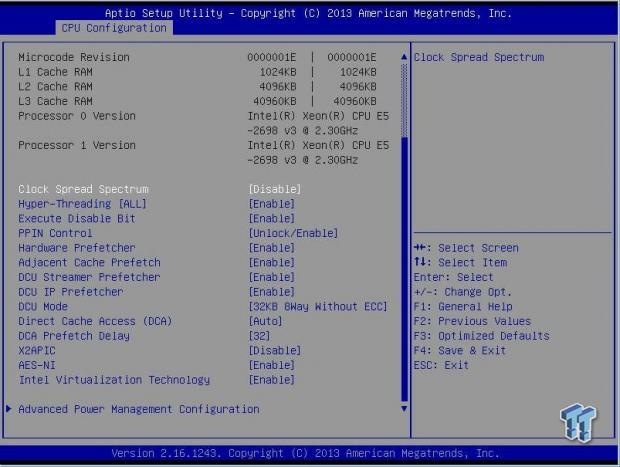
This is the advanced Boot Feature menu. There are many options in this area, most work just fine with default settings.
Hardware Prefetcher (available when supported by the CPU):
If set to Enable, the Hardware Prefetcher will prefetch streams of data and instructions from the main memory to the L2 cache to improve CPU performance.
Adjacent Cache Prefetch (Available when supported by the CPU):
Select Enable and the CPU will prefetch both cache lines for 128 bytes as comprised.
DCU (Data Cache Unit) Streamer Prefetcher (available when supported by the CPU):
The DCU Streamer Prefetcher will prefetch data streams from the cache memory to the DCU (Data Cache Unit) to speed up data accessing and processing to enhance CPU performance.
Direct Cache Access (DCA):
Intel DCA (Direct Cache Access) Technology will improve the efficiency of data transferring and accessing.
X2APIC (Advanced Programmable Interrupt Controller):
Based on Intel's Hyper-Threading architecture, each logical processor (thread) is assigned 256 APIC IDs (APIDs) in 8-bit bandwidth. When this feature is set to Enable, the APIC ID will be expanded from 8-bit (X2) to 16 bit to provide 512 APIDs to each thread to enhance CPU performance.
AES-NI:
Select Enable to use the Intel Advanced Encryption Standard (AES) New Instructions (NI) to ensure data security.
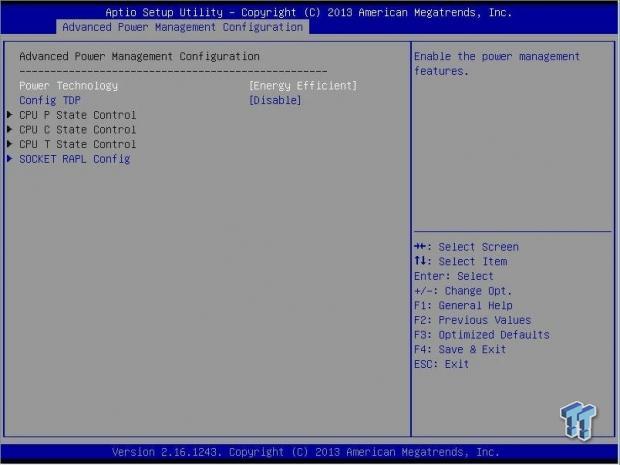
This is the CPU Advanced Power Management Configuration screen.
CPU P-State Control (available when Power Technology is set to Custom):
This includes EIST (P-States), Turbo Mode, and P-State Control.
This feature is used to change the P-State (Power-Performance State) coordination type. P-State is also known as "SpeedStep" for Intel processors. Select HW_ALL to change the P-State coordination type for hardware components only. Select SW_ALL to change the P-State coordination type for all software installed in the system. Select SW_ANY to change the P-State coordination type for a software program in the system.
CPU C-State Control (available when Power Technology is set to Custom):
This includes CPU C3 Report and Enhanced Halt State (C1E).
CPU T-State Control (available when Power Technology is set to Custom):
This includes ACPI (Advanced Configuration Power Interface) T-States.
CPU T-States supports CPU throttling by the operating system to reduce power consumption.
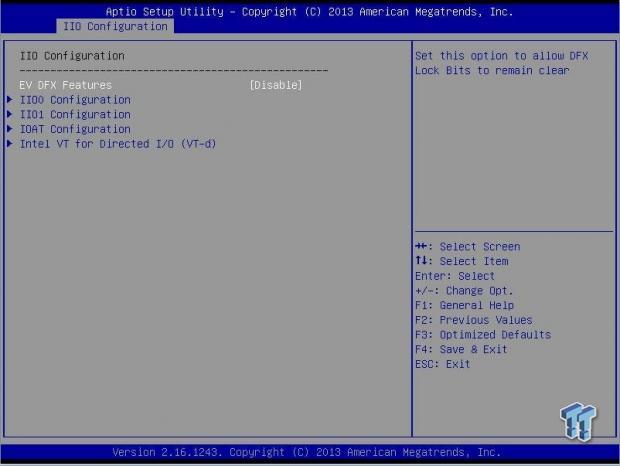
Now we are looking at the North Bridge IIO configuration menu.
EV DFX (Device Function On-Hide) Feature:
When this feature is set to Enable, the EV_DFX Lock Bits that are located on a processor will always remain clear during electric tuning.
IIO0 Configuration:
IIO1 Port 1A, 2A, and 3A Link Speed.
Use this item to configure the link speed of a PCI-E device installed on the PCIE slot specified by the user. The options are Gen1 (2.5 GT/s), Gen2 (5 GT/s), and Gen3 (8 GT/s).
IIO1 Configuration:
IIO2 Port 1A, 2A and 3A Link Speed.
Use this item to configure the link speed of a PCI-E device installed on the PCIE slot specified by the user. The options are Gen1 (2.5 GT/s), Gen2 (5 GT/s), and Gen3 (8 GT/s).
IOAT (Intel® IO Acceleration) Configuration:
Enable IOAT
Select Enable to enable Intel I/OAT (I/O Acceleration Technology) support, which will significantly reduce CPU overhead by leveraging CPU architectural improvements and freeing the system resource for other tasks.
Intel VT for Directed I/O (VT-d):
Select Enable to use Intel Virtualization Technology support for Direct I/O VT-d support by reporting the I/O device assignments to the VMM (Virtual Machine Monitor) through the DMAR ACPI tables. This feature offers fully-protected I/O resource sharing across Intel platforms, providing greater reliability, security, and availability in networking and data-sharing.
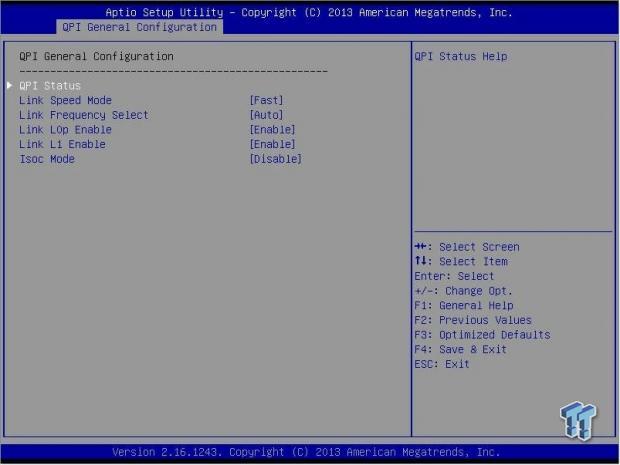
Here we are looking at the QPI General Configuration menu.
Link Frequency Select:
Use this item to select the desired frequency for QPI Link connections. The options are 6.4GB/s, 8.0GB/s, and 9.6GB/s.
Isoc Mode:
Select Enable for Isochronous support to meet QoS (Quality of Service) requirements. This feature is especially important for Virtualization Technology.
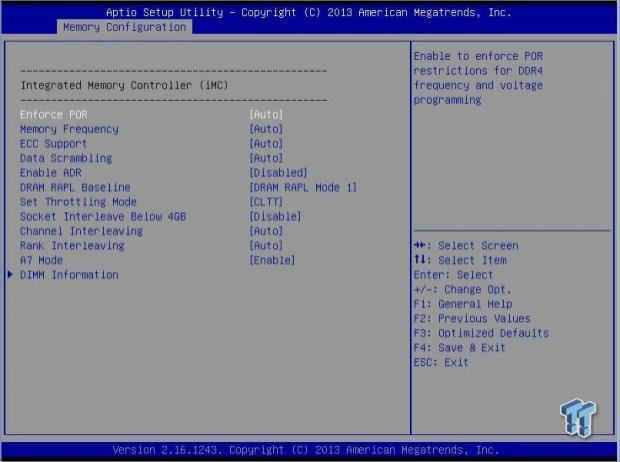
Here we are looking at the Memory Configuration menu.
Data Scrambling:
Select Enabled to enable data scrambling to enhance system performance and data integrity.
DRAM RAPL (Running Average Power Limit) Baseline:
Use this feature to set the run-time, power-limit baseline for the DRAM modules.
Set Throttling Mode:
Throttling improves reliability, and reduces power consumption in processors via automatic voltage control during processor idle states.
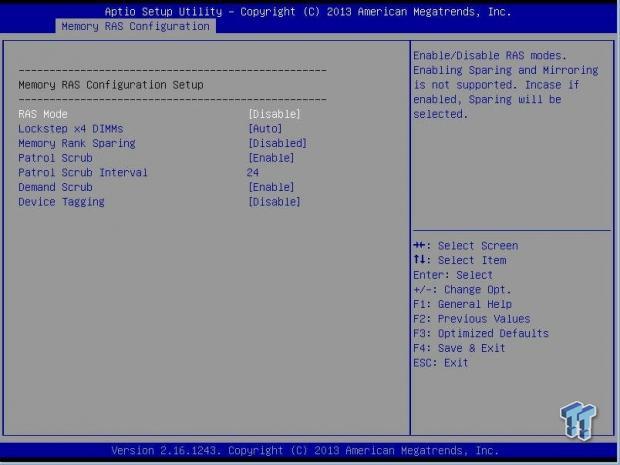
Here we are looking at the Memory RAS Configuration menu.
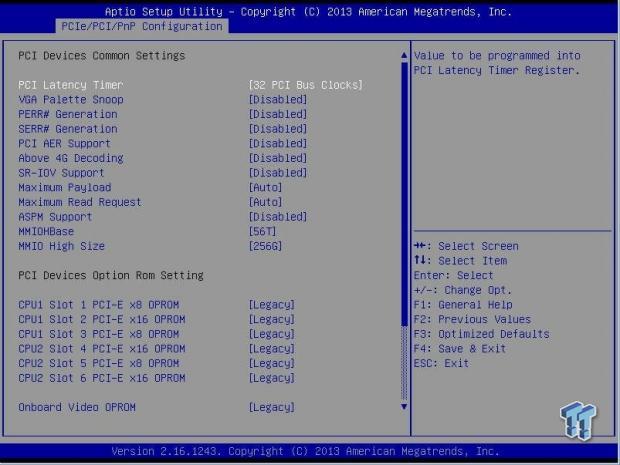
Now we are looking at the PCH SATA Configeration menu.
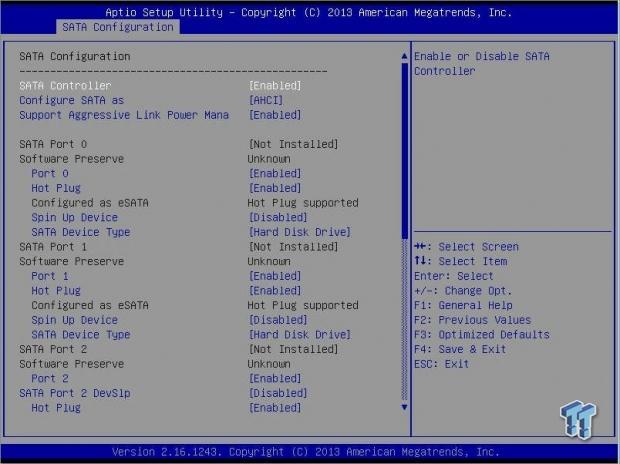
Now we are looking at the PCH SATA Configeration menu.
Configure SATA as:
Select IDE to configure a SATA drive (specified by the user) as an IDE drive. Select AHCI to configure a SATA drive (specified by the user) as an AHCI drive. Select RAID to configure a SATA drive (specified by the user) as a RAID drive.
Support Aggressive Link Power Management:
When this item is set to Enabled, the SATA AHCI controller manages the power usage of the SATA link. The controller will put the link into a low power state when the I/O is inactive for an extended period of time, and the power state will return to normal when the I/O becomes active.
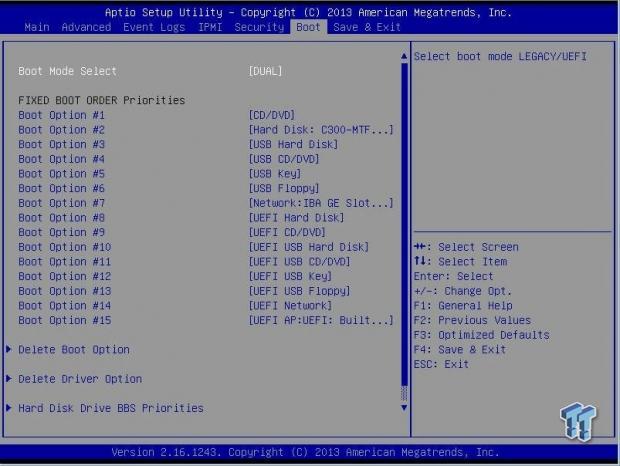
The last menu is the Boot Options menu.
Remote Management

We find our remote access IP address located in the BIOS under the IPMI Tab. In our case, this was 192.182.1.11. Enter that into your browser, and you will see the login screen.
To login use:
Username: ADMIN
Password: ADMIN
As a best practice, Administrative users should change factory default Username/Password logins before connecting any new server to their network.
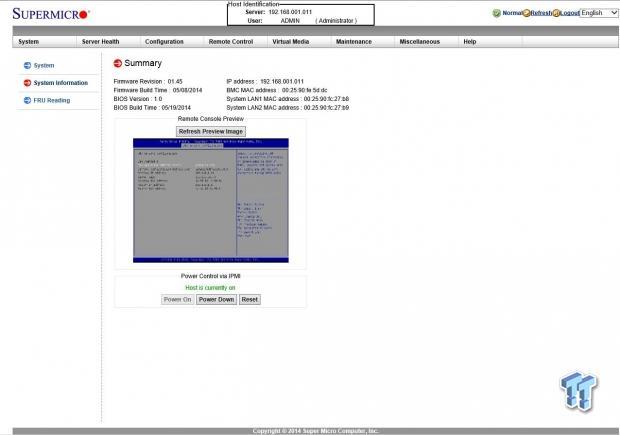
After logging in, we come to the home screen and see system information displayed.
There is also a remote control option for iKVM.
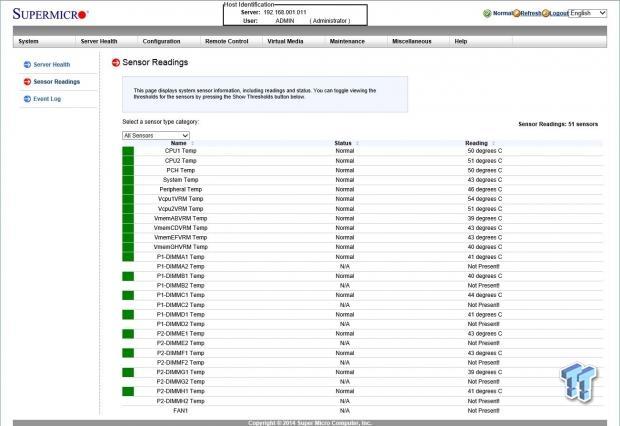
The next tab is the Sensor Readings menu.
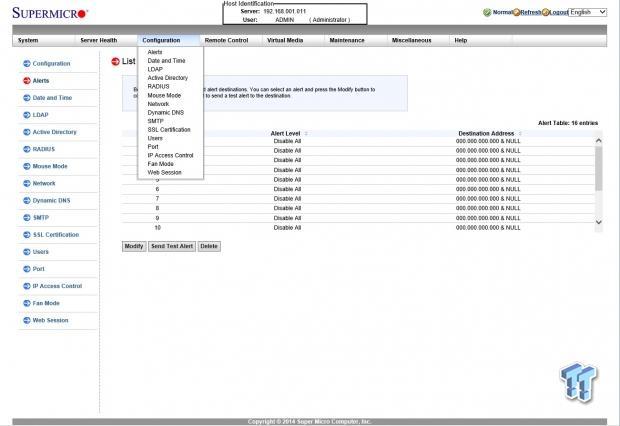
The Configuration menu allows you to change many features on the server, Active Directory settings, DNS, LDAP, and much more.
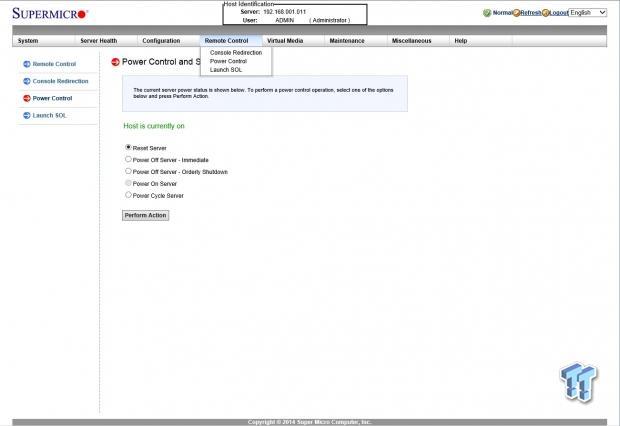
The Power Control and Status menu allows you to power on, shut down, restart, and cycle the server.
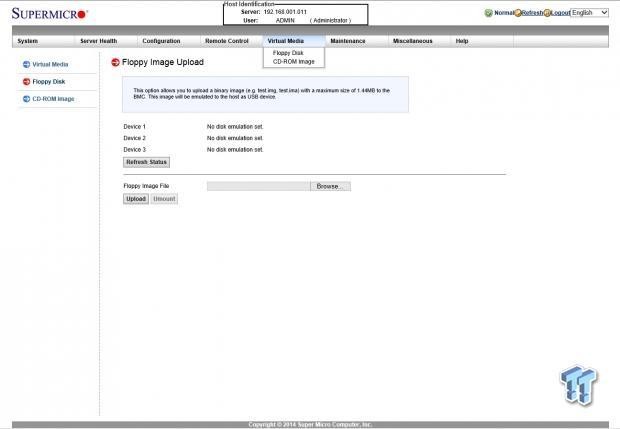
The Virtual Media menu allows you to mount or share virtual media such as Floppy Disks and CD-ROM images.
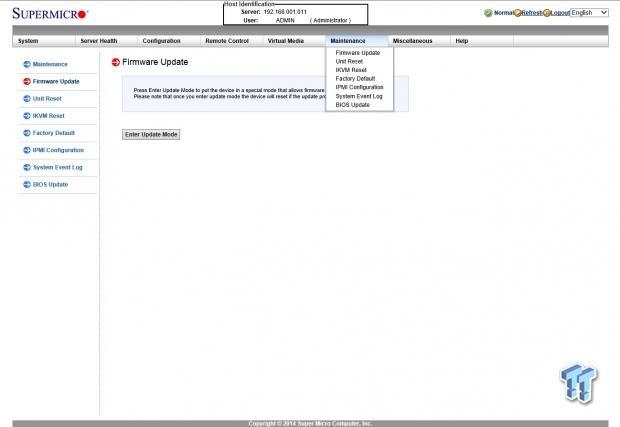
The Maintenance menu allows you to update the firmware, and restore factory defaults.
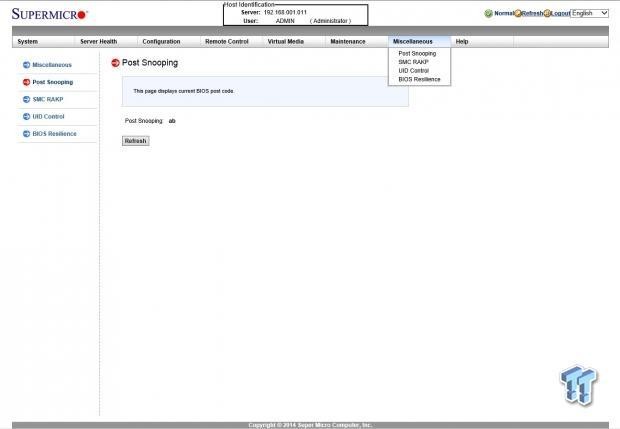
The Miscellaneous menu allows post snooping, SMC RAKP enable/disable, UID control, and BIOS recovery.
Software
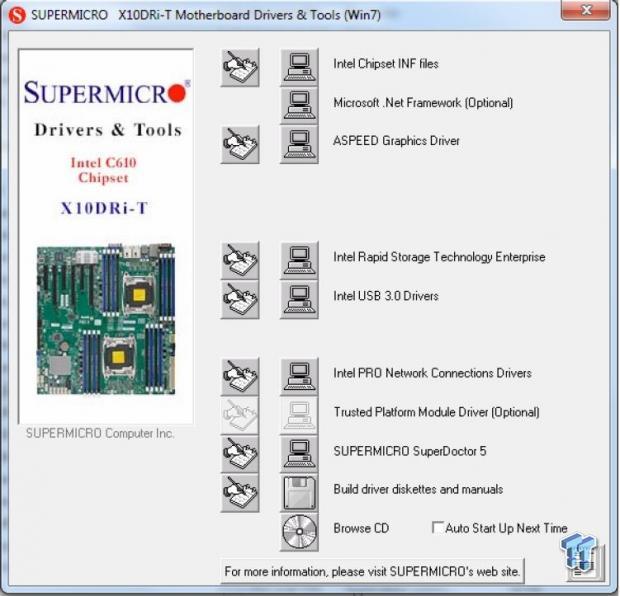
Here we see the drivers and tools menu. We are happy to see that Supermicro has included a driver ISO file that we can download to install drivers and tools.
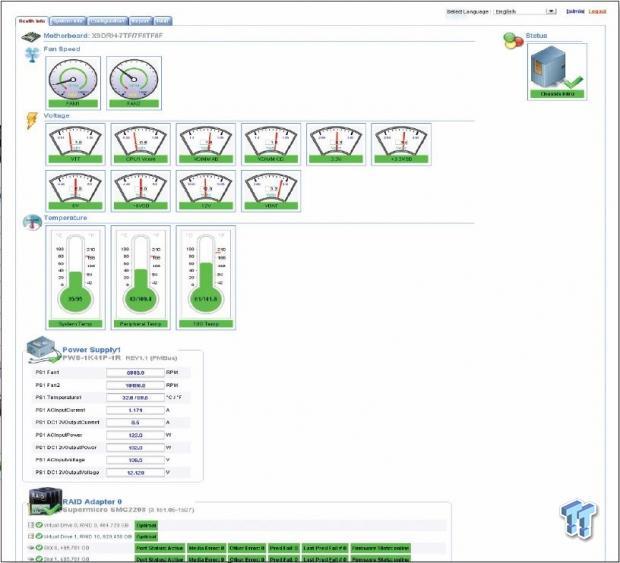
The Supermicro SuperDoctor 5 is a hardware-monitoring program that functions in a command-line or web-based interface in Windows and Linux operating systems. The program monitors system health information such as CPU temperature, system voltages, system power consumption, fan speed, and provides alerts via email, or Simple Network Management Protocol (SNMP).
SuperDoctor 5 comes in local and remote management versions, and can be used with Nagios to maximize system monitoring. With SuperDoctor 5 Management Server (SSM Server), you can remotely control power on/off, and reset chassis intrusion for multiple systems with SuperDoctor 5, or IPMI. SD5 Management Server monitors HTTP, FTP, and SMTP services optimize the efficiency of your operation.
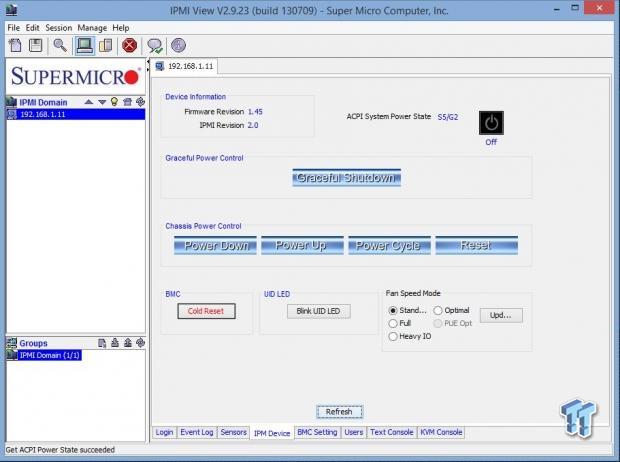
IPMIView is a GUI-based software application that allows administrators to manage multiple server systems through BMC. IPMIView monitors and reports on the status of servers, and also supports remote KVM and Virtual Media.
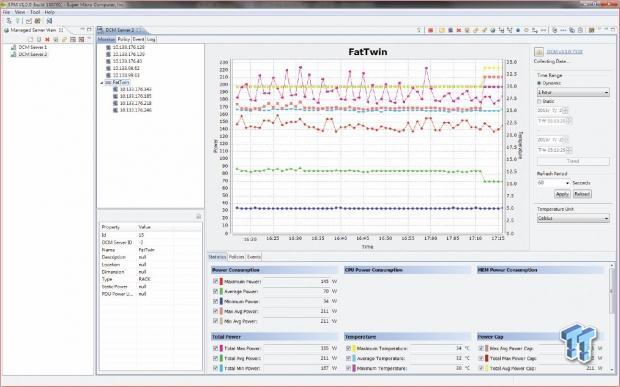
Supermicro Power Manager (SPM) is a power management tool that allows you to improve system power utilization. Administrators can configure policies by data center, room, row, rack, target machine, or logical groups, and can be triggered by condition, power, or temperature thresholds.
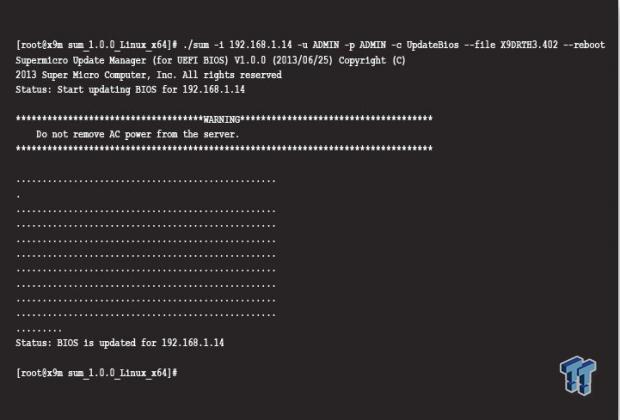
Supermicro Update Manager (SUM) remotely updates the BIOS and BMC/IPMI firmware, and system settings. The X10 based machines through in-band and OOB (out-of-band) BMC/IPMI communication channels.
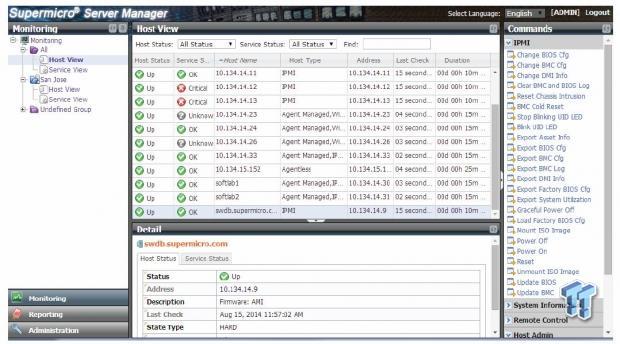
Supermicro Server Manager (SSM) provides capabilities to monitor the health of servers, and many other features.
Test System Setup
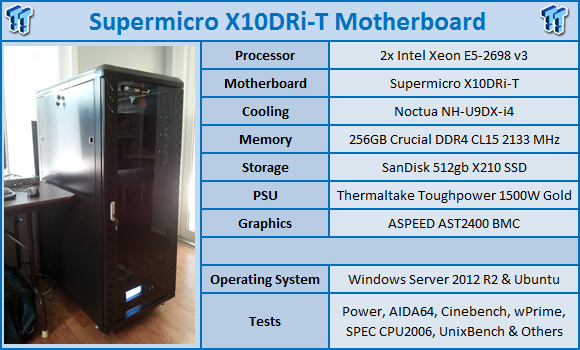
We would like to thank Supermicro, Crucial, SanDisk, Yokogawa, Thermaltake, Noctua, SPEC, Passmark, Primate Labs, and AIDA64 for their support in providing parts for our test system.
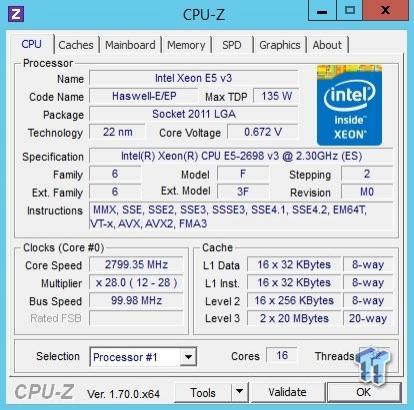
The platform that the X10DRi-T uses is the Wellsburg (Intel C612), and new Haswell-EP processors. The processor we will be using is the Intel Xeon E5-2698 v3, which features 16 cores with hyper-threading used on these tests.
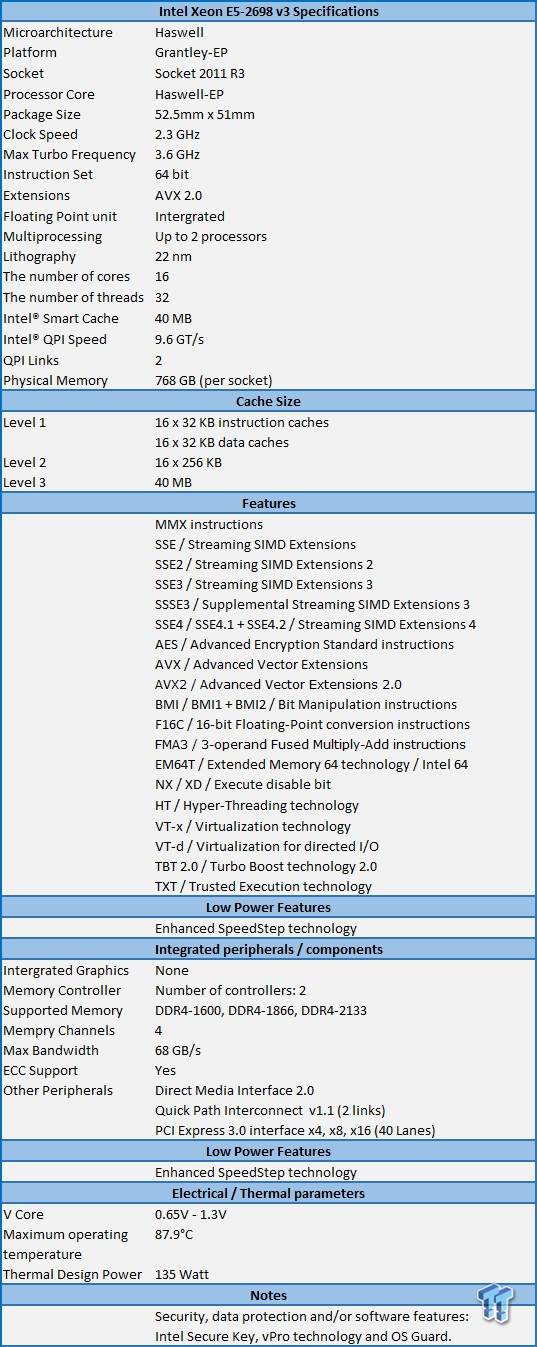
The Wellsburg Platform (Intel C612) will have support provided for four to 18 cores with dual socket capability. TDP ranges from 55W to 160W for workstations.
Memory is now DDR4, and can give a frequency of up to 2133 MHz. The E5-2600 v3 processors use two QPI 1.1 channels with up to 9.6 GT/s. These processors support PCIe 3.0 with up to 8 GT/s and 40 lanes. The chipset will be Wellsburg PCH. This gives support for a huge number of SATA ports (ten). A large number of USB devices can be used with six USB 3.0, and eight USB 2.0 ports. Wellsburg (C612) also supports DMI2 with 4x lanes.

In our tests, we will be using the new Crucial DDR4 memory, which has a speed of 2133 MHz, and is rated at CL15. We have already taken a look at these memory kits, which you can find here: Crucial DDR4-2133 DRx4 RDIMM Memory Review - Testing up to 256GB.
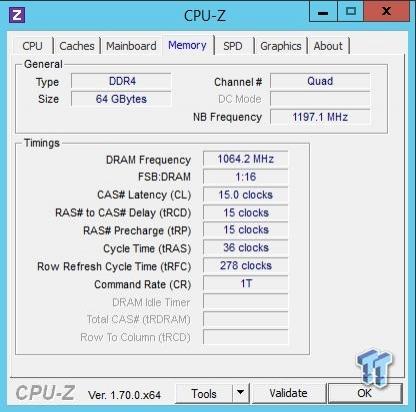
Here we can see the timings of the Crucial DDR4 memory that we will be using in our tests.
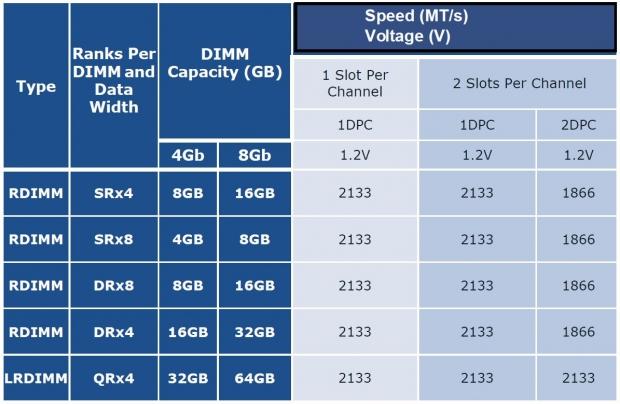
Here we see how memory in Slot/DIMM's per channel can effect memory speed.
In the test lab, we found many new systems we are testing with multiple video cards and other expansion devices were starting to have larger power supply needs. We have now upgraded our test bed with a new Thermaltake Toughpower 1500W Gold PSU. We have already pushed this PSU in the lab to near max loads, and it has performed flawlessly. Even with max loads under full stress testing, the Toughpower 1500W Gold PSU hardly makes any noise at all, which we really like.
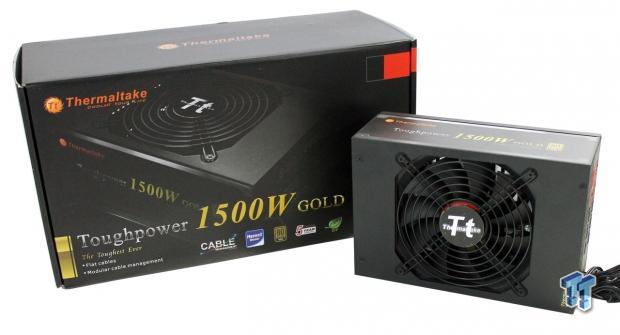
Here we see the Thermaltake Toughpower 1500W Gold PSU with its retail box. We like this power supply, as it can handle fully loaded Dual CPU systems and 4x workstation video cards, and a whole host of other expansion devices.
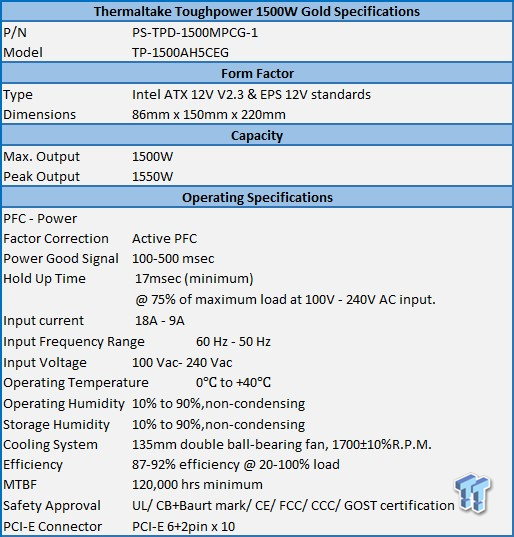
Here are just a few specifications for the Toughpower 1500W Gold PSU. We have also added a few more benchmarks to our tests, mostly geared at memory testing. So let us see how well the X10DRi-T performs.
CPU Benchmarks
Cinebench 11.5
CINEBENCH is a real-world, cross platform test suite that evaluates your computer's performance capabilities. The test scenario uses all of your system's processing power to render a photorealistic 3D scene. This scene makes use of various different algorithms to stress all available processor cores. You can also run this test with a single-core mode to give a single-core rating.
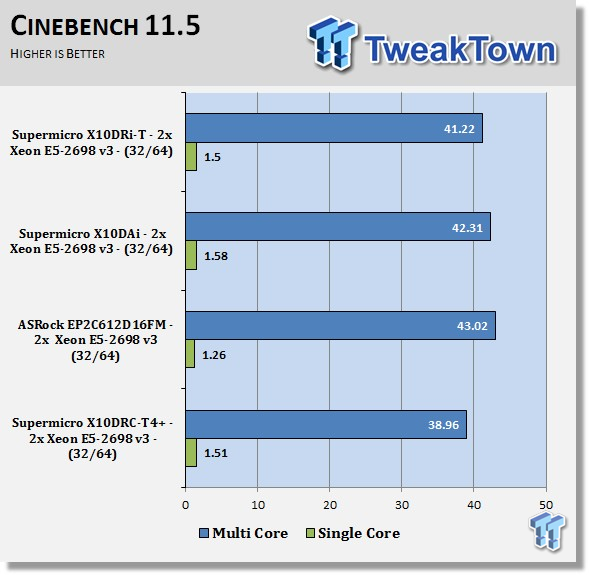
Here we are looking at our Cinebench 11.5 tests; the X10DRi-T shows a good score here. X10DRi-T has good BIOS optimization for performance in this test. All motherboards using the new C612 chipset and Haswell-EP processors are performing very close to each.
Cinebench R15

The X10DRi-T has an average score in CINEBENCH R15, and it still shows very good performance optimization.
wPrime
wPrime is a leading multi-threaded benchmark for x86 processors that tests your processor performance. This is a great test to use to rate the system speed; it also works as a stress test to see how well the system's cooling is performing.
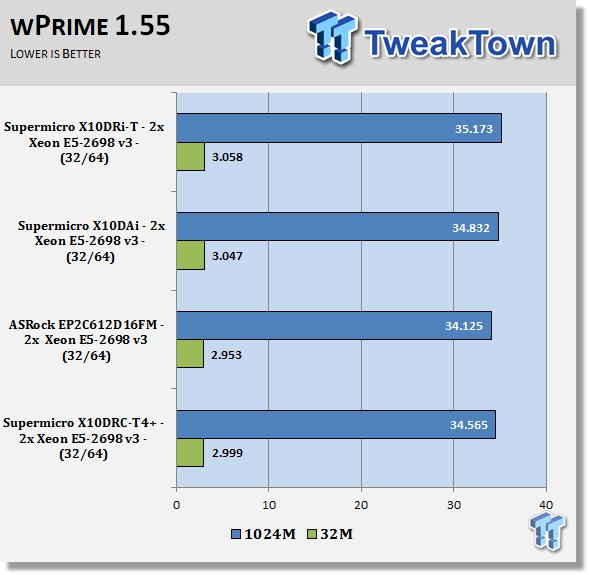
In wPrime, the X10DRi-T has a slightly slower score. As we said before, these small score adjustments are not much to be concerned about with these tests.
Memory & System Benchmarks
AIDA64
AIDA64 memory bandwidth benchmarks (Memory Read, Memory Write, and Memory Copy) measure the maximum achievable memory data transfer bandwidth.
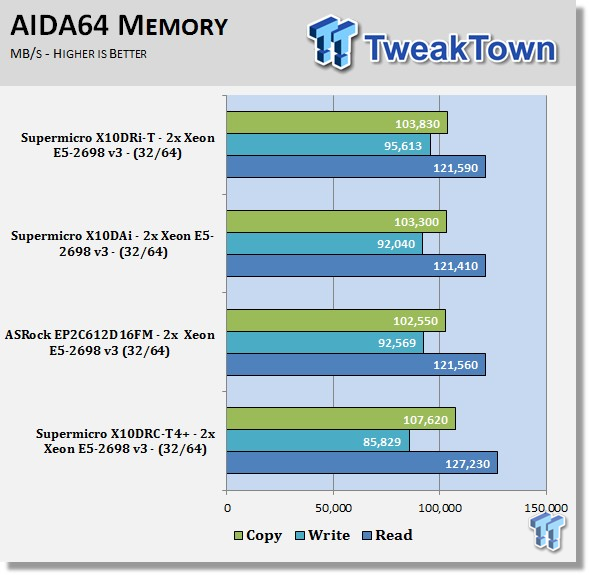
Memory bandwidth for the X10DRi-T is looking very good. Although there are no huge increases of bandwidth, the X10DRi-T is showing good strong bandwidth numbers.
Again, we see all motherboards using the new C612 chipset and Haswell-EP processors are performing very close to each.
Linpack
Intel Optimized LINPACK Benchmark is a generalization of the LINPACK 1000 benchmark. It solves a dense (real*8) system of linear equations (Ax=b), measures the amount of time it takes to factor and solve the system, converts that time into a performance rate, and tests the results for accuracy.
Linpack is a measure of a computer's floating-point rate of execution ability, measured in GFLOPS (Floating-point Operations per Second); ten billion FLOPS = ten GFLOPS.
Linpack is a very heavy compute application that can take advantage of the new AVX2 instruction. Since it puts a very high load on the system, it is also a good stress test program.
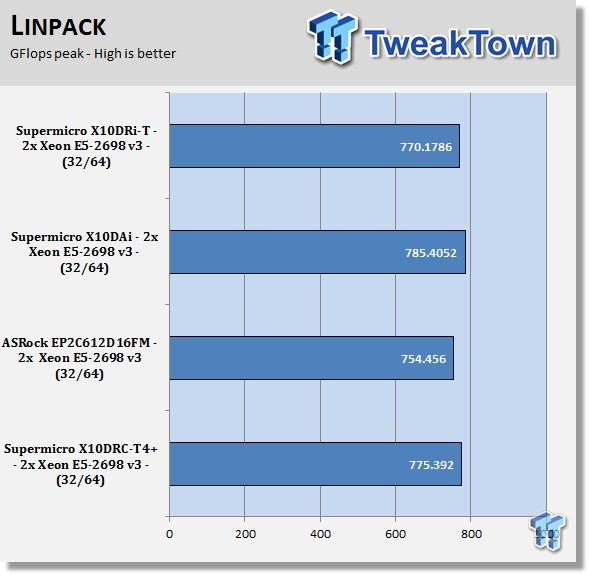
Linpack shows strong bandwidth numbers and is comparable to other motherboards we have tested. These results are almost 2x's faster than our Ivy Bridge-EP tests and shows just how well the new Haswell-EP platforms perform. These speeds coupled with fast DDR4 should give a real boost to application performance.
Geekbench - Stream
Geekbench 3 is Primate Labs' cross-platform processor benchmark, with a new scoring system that separates single-core and multi-core performance, and new workloads that simulate real-world scenarios. It also includes STREAM based memory tests, which we will include on our reviews.
According to Primate Labs', the STREAM memory tests perform these functions:
- STREAM copy: The stream copy workload tests how fast your computer can copy large amounts of data in memory. It executes a value-by-value copy of a large list of floating point numbers.
- STREAM scale: This workload is similar to stream copy, but each value is multiplied by a constant during the copy.
- STREAM add: The stream add workload reads two large lists of floating point numbers value-by-value, adds corresponding values, and stores the result in a third list.
- STREAM triad: This workload combines stream add and stream scale. It reads two lists of floating point numbers value-by-value, multiplies one of the numbers by a constant, adds the result to the other number, and writes that result to a third list.
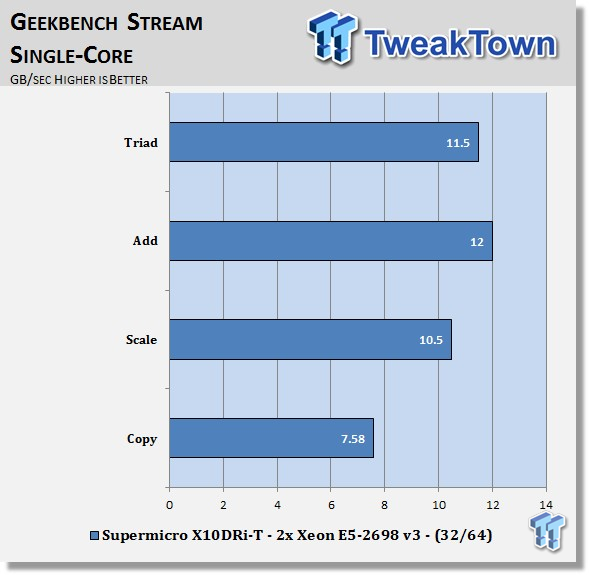
Here we are looking at the single-core STREAM memory tests. Bandwidth is about where it is expected to be for single-core applications.
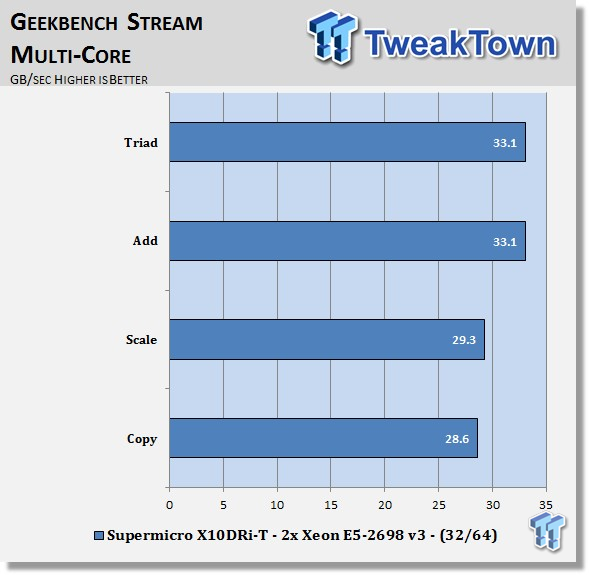
Now we are looking at multi-core STREAM tests. The speeds we are seeing are a little faster than advertised bandwidths for our Crucial Memory kits, which shows these new X10 platforms from Supermicro can squeeze out fast memory bandwidth.
Passmark - PerformanceTest 8 - Memory
We will also start using Passmark Performance Memory tests on our reviews.
According to Passmark: This memory test suite contains a number of tests that exercise the memory sub-system of the computer (RAM). All tests use a combination of 32-bit and 64-bit data when reading or writing from or to RAM.
Memory - Allocate small block:
This test measures the time taken to allocate and free small zeroed memory blocks (around 100KB block size).
Memory - Cached:
This test measures the time taken to read a small block of memory. The block is small enough to be held entirely in cache (if one is present).
Memory - UnCached:
This test measures the time taken to read a large block of memory. The block is too large to be held in cache.
Memory - Write:
This test measures the time taken to write information into memory.
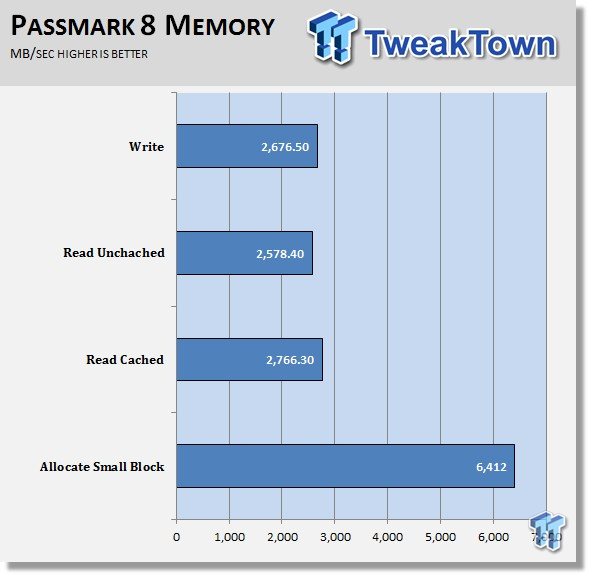
Just like in Geekbench STREAM Memory tests, we see very good speeds in our tests with Passmark 8 memory test.
UnixBench and SPEC CPU2006v1.2
UnixBench 5.1.3
UnixBench has been around for a long time now, and is a good general-purpose bench to test on Linux based systems.
This is a system benchmark, and it shows the performance of single-threaded and multi-threaded tasks.
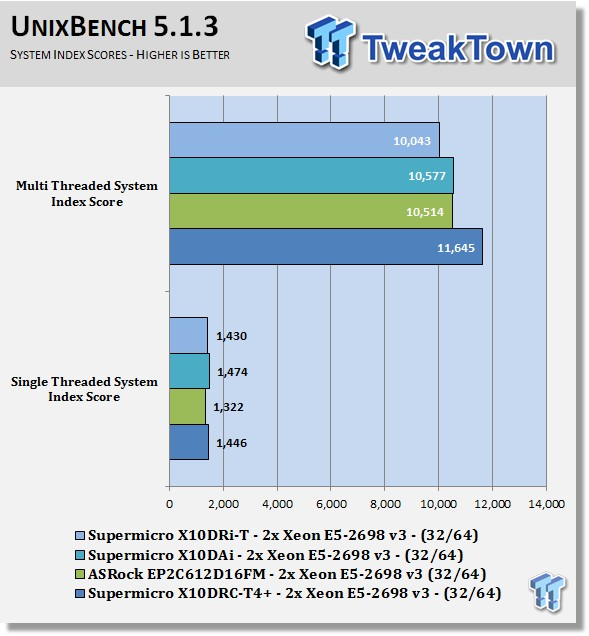
Synthetic benchmarks only show part of the performance of a motherboard. When using tests that are more complex, we will start to see a different trend in the scores.
UnixBench starts to show what the X10DRi-T can really do well, and that is multi-threaded workloads.
SPEC CPU2006 v1.2
SPEC CPU2006v1.2 measures compute intensive performance across the system using realistic benchmarks to rate real performance.
In our testing with SPEC CPU2006 we use the following basic commands to run these tests:
Runspec --tune=base --config=tweaktown.cfg; then int, or fp.
To do multi-threaded, we add in --rate=64.
When SPEC CPU first came out, these tests could take up to a week to run, but as computers become faster, our tests now take up to four days for a full run, and even less on some systems.
The user can do many thing to effect the results of CPU2006 runs, such as compiler optimizations, add-ons like SmartHeap, and different commands used to start the tests.
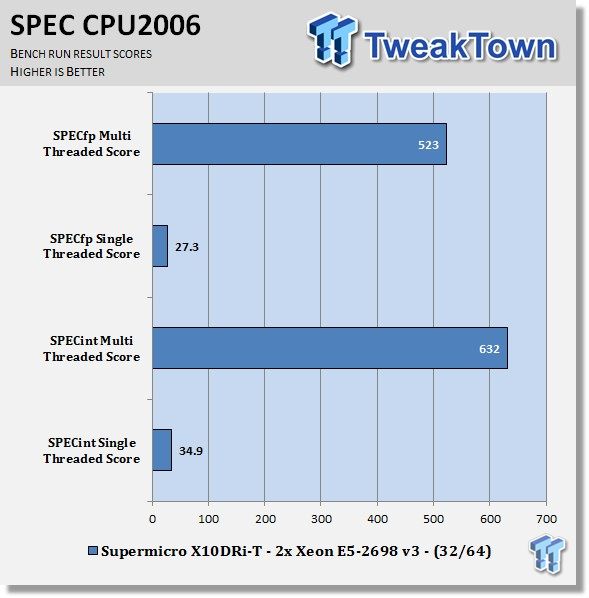
This benchmark has many different commands to use depending on what the user is looking for. For our tests, we used basic commands that run a full test with a base tune.
Here you can see the SPEC scores after full runs for Integer (int) and Floating Point (fp) tests.
Single-core runs show how fast (speed) a CPU can perform a given task. In the multi-core runs, we set SPEC CPU2006v1.2 to use all threads to measure the throughput of the system.
The additional cores/threads of this system have a huge impact on performance in these tests, and really show the amount of horsepower that a dual-socket system has over a single-socket board.
Single-threaded results are still very important, but when you need many single-threaded apps to run, moving to a CPU with more cores is the way to go.
This is where the X10DRi-T starts to shine: multi-threaded interger workloads.
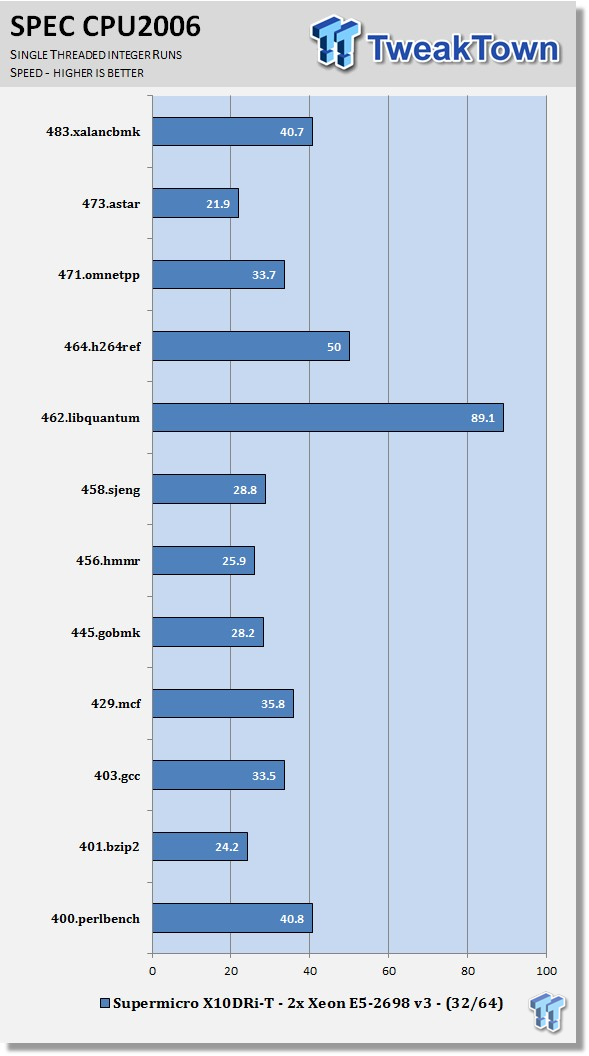
By looking at the results of single-threaded integer runs, we can get an idea of speed at which the E5-2698 v3's can crunch through the different integer tests. Not all CPUs are equal here, and ones that have a higher speed will perform these tests faster. Naturally, using an overclocked system, or CPUs with a higher stock speed, will generate higher results.

Now we run the test using all 32 cores/64 threads cores on the E5-2698 v3 processors to measure the throughput of the system. In this test, more cores/threads will have a greater effect on the outcome.
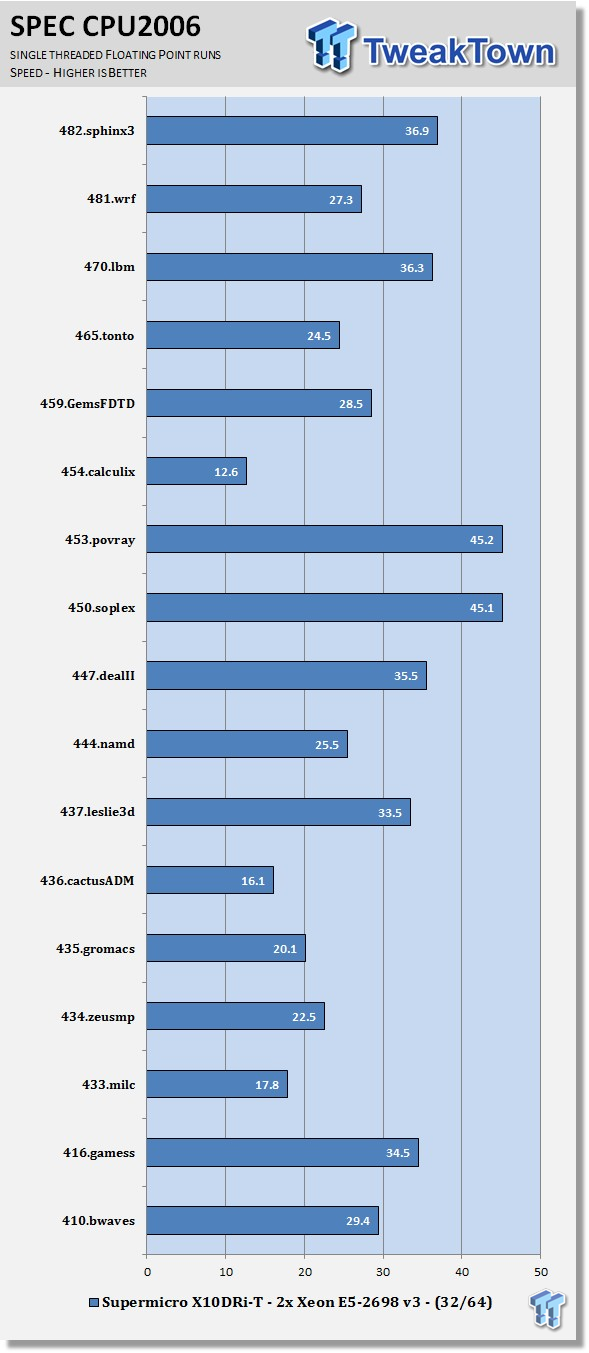
Just like the integer tests, we now run the floating-point tests in single-threaded (speed) mode.
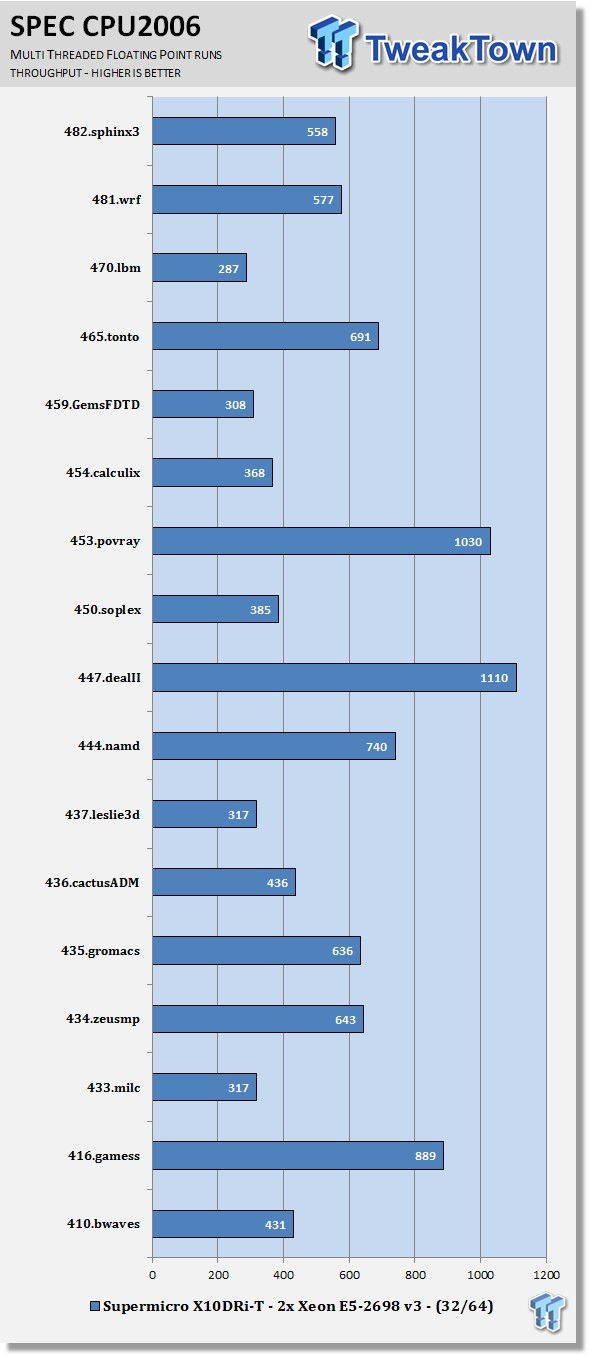
Here we see the results of the multi-core floating-point run that uses all 32 cores/64 threads cores on the E5-2698 v3 processors. Like the multi-threaded integer test, more cores/threads will have a greater impact on the test.
Just like the integer multi-threaded tests, the X10DRi-T really takes off here.
Power Consumption & Final Thoughts
Power Consumption
We have upgraded our power testing equipment, and now use a Yokogawa WT310 power meter for testing. The Yokogawa WT310 feeds its data through a USB cable to another machine where we can capture the test results.
To test total system power use, we used AIDA64 Stability test to load the CPU, and then recorded the results. We also now add in the power use for a server from off state, to hitting the power button to turn it on, and take it all the way to the desktop. This gives us data on power consumption during the boot up process.
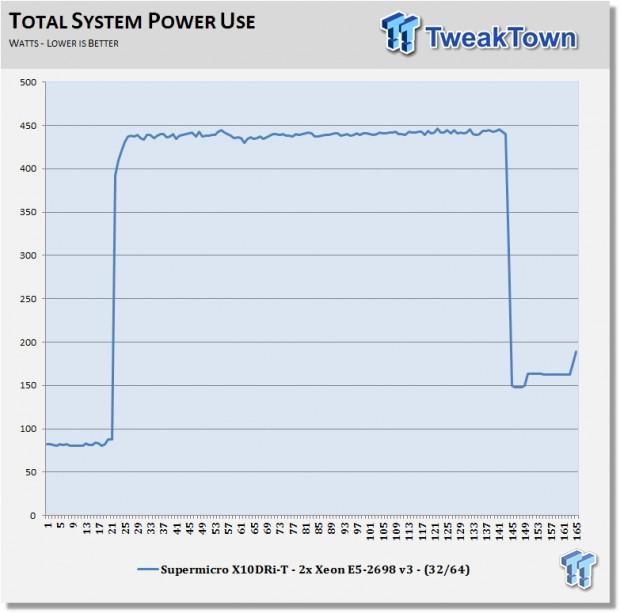
The X10DRi-T uses ~85 watts at idle on the desktop, which is about 45 watts less than Ivy Bridge-EP setups we have run. The max power use is also very good. We find this system to be energy efficient, which will save on power bills in the end.
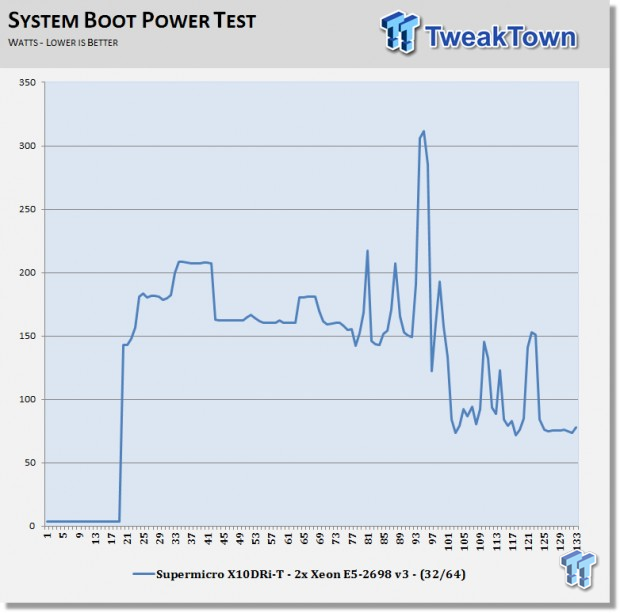
With the X10DRi-T, we see only peak power use of ~310 watts during the boot up process. The system then settles down to ~85 watts after the boot up is completed.
Final Thoughts
General-purpose server motherboards need to be able to handle a different system needs and requirements; the X10DRi-T can handle many different types of workloads with ease.
The new Supermicro X10DRi-T is based on the new Haswell-EP processors, so this server motherboard can pack a punch in performance.
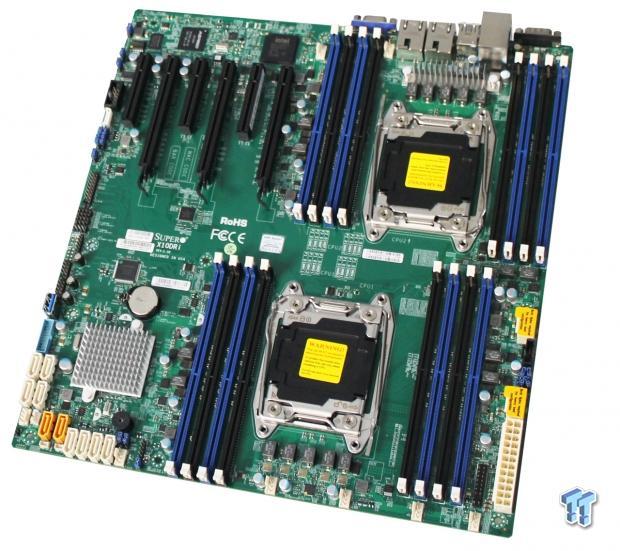
The Supermicro X9DR3/i-F SKU's were Supermicro's top sellers because they filled many different roles, and were top performers. The X10DRi-T is geared to bring performance to a new level in the same roles.
One thing we like about these new motherboards is the low power use on idle states. This is where power use can really start to cost a lot in power bills; in addition, it helps to keep the server cooler. We have not had any heating issues whatsoever in the new Haswell-EP based servers. Supermicro has done a nice job implementing power saving features on the new line up of motherboards, and the X10DRi-T is no different from the other Supermicro boards we have tested.
When it comes to cases for the X10DRi-T, Supermicro has many cases to pick from; we counted thirteen different cases - everything from 2U, all the way to big 4U storage boxes.
We have to say, we really like the performance of the new Haswell-EP Xeon E5-2600 v3 processors and DDR4 memory. The X10DRi-T makes use of the new C612 chipset, allowing this high performance server motherboard loaded with features to fill a variety of server needs.
There is not much to dislike about the X10DRi-T; it really did everything we expected it to do with ease. We find BIOS optimizations, chipset feature list, and network and storage options make the X10DRi-T a well-designed server motherboard that is able to deliver high performance, and use lower power than previous motherboards.
PRICING: You can find the Supermicro X10DRi-T for sale below. The prices listed are valid at the time of writing, but can change at any time. Click the link to see the very latest pricing for the best deal.
United States: The Supermicro X10DRi-T retails for $550.17 at Amazon.

| Performance | 97% |
| Quality including Design and Build | 96% |
| General Features | 95% |
| Bundle and Packaging | 90% |
| Value for Money | 97% |
| Overall | 95% |
The Bottom Line: Designing a high-volume server motherboard requires just the right balance in performance and features. That is just what Supermicro did with the X10DR-T. It has the ability to fill many different server needs, and is energy-efficient to lower running costs.
PRICING: You can find products similar to this one for sale below.
 United
States: Find other tech and computer products like this
over at Amazon.com
United
States: Find other tech and computer products like this
over at Amazon.com
 United
Kingdom: Find other tech and computer products like this
over at Amazon.co.uk
United
Kingdom: Find other tech and computer products like this
over at Amazon.co.uk
 Australia:
Find other tech and computer products like this over at Amazon.com.au
Australia:
Find other tech and computer products like this over at Amazon.com.au
 Canada:
Find other tech and computer products like this over at Amazon.ca
Canada:
Find other tech and computer products like this over at Amazon.ca
 Deutschland:
Finde andere Technik- und Computerprodukte wie dieses auf Amazon.de
Deutschland:
Finde andere Technik- und Computerprodukte wie dieses auf Amazon.de
Related Tags
